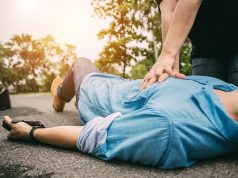Second study shows improved one-month survival with favorable neurological outcome with public AED use
MONDAY, Nov. 5, 2018 (HealthDay News) — Public automated external defibrillators (AEDs) are cost-effective for out-of-hospital cardiac arrest (OHCA) and are associated with better outcomes, according to two studies scheduled to be presented at the annual meeting of the American Heart Association, held from Nov. 10 to 12 in Chicago.
Lars W. Andersen, M.D., M.P.H., Ph.D., from the Research Center for Emergency Medicine in Arhus, Denmark, and colleagues compared the cost-effectiveness of public AEDs to no AEDs for OHCA in the United States. In their analysis, they assumed a 52 percent relative increase in survival to hospital discharge with favorable neurological outcome with AED use. The researchers found that the no-AED strategy resulted in 1.63 quality-adjusted life-years (QALYs) at a cost of $42,757. An additional 0.26 QALYs were yielded with the AED strategy, for an incremental increase in cost of $13,793 per individual. The incremental cost-effectiveness ratio was $53,797 per QALY gained with the AED strategy.
Takefumi Kishimori, M.D., from Kyoto University in Japan, and colleagues examined the effect of public-access AED use for OHCA patients in public locations. The researchers found that 19.3 percent of the 1,743 eligible patients received public-access AED pad application. Survival to one month with favorable neurological outcome was significantly increased in the pad application group versus the non-pad application group (29.8 versus 9.7 percent; adjusted odds ratio, 2.85; 95 percent confidence interval, 1.73 to 4.68; adjusted odds ratio after propensity score matching, 2.83; 95 percent confidence interval, 1.40 to 5.72). For patients with shockable or non-shockable rhythms, the adjusted odds ratios were 3.36 (95 percent confidence interval, 1.78 to 6.35) and 2.38 (95 percent confidence interval, 0.89 to 6.34), respectively.
“Public-access AED pad application was associated with better outcome among OHCA patients with shockable rhythm, and the trend was the same among those with non-shockable rhythm,” Koshimoi and colleagues write.
Copyright © 2018 HealthDay. All rights reserved.








